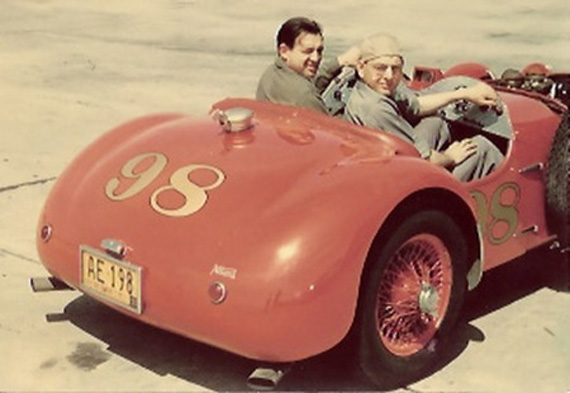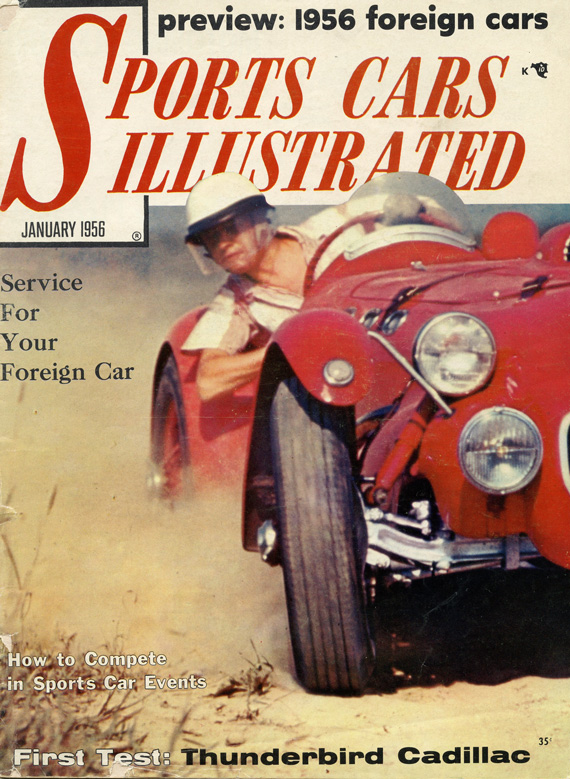
Frank Burrell with Cal Connell of Detroit Racing Equipment sitting in the Goldschmidt Allard. The Burrell-modified Allard helped Goldschmidt win the 1950 Watkins Glen Grand Prix.
By Pete Vack
“I have to say, that despite all, I liked Erwin Goldschmidt.” Cameron Argetsinger had the opportunity to know the flying Allard driver better than most others. In fact, it was Argetsinger who gave Goldschmidt the opportunity to race at Watkins Glen.
The Goldschmidt family had lived in Germany for generations, and Erwin’s father Jacob was a banker who helped bring down the rampant inflation of the 1920s. But fearing the Nazis, Jacob moved his family to Great Britain in the early 1930s. Erwin was educated at Oxford and Eaton, and became fluent in seven languages. Erwin was a very bright boy. The family then migrated to the United States, and Erwin joined the OSS under “Wild Bill” Donovan.
In 1949 Erwin decided to get involved with sports car racing, and ordered an Allard J2, chassis 1556, which was delivered on March 21 1950. He took it to Connell Cadillac Company in Detroit, and there Calvin Connell, the owner’s son, built up and installed a racing Cadillac engine. (According to Eric Davison, Cal Connell was a Detroit Cadillac dealer who used a lot of stuff from DRE- Detroit Racing Equipment- some of which had been designed by Frank Burrell.)
Goldschmidt learned to drive fast courtesy of the Pennsylvania Turnpike. As Argetsinger relates the story, Goldschmidt was approaching one of the seven tunnels when he saw that the road was blocked with emergency vehicles. Of course he had to stop, at which time the police asked to see his toll ticket. The time indicated Erwin had been averaging over 100 mph. “Of course,” said Argetsinger, “The emergency vehicles were there to stop the Allard, as they had been waiting for him.”
Wanting to drive the car in the Watkins Glen Grand Prix, Goldschmidt met Argetsinger on a weekend in Long Island with Charlie Addams and Sam Cobean. Goldschmidt decided to drive the Allard to his apartment on Park and 54th in New York and asked Argetsinger if he’d like to come along. “It was raining. The distance was about 80 miles. Erwin made the trip in 45 minutes. I never got wet, despite being a passenger in the Allard with the top down,” said Argetsinger. “It was in this fashion that Erwin convinced me he was well qualified to enter the Watkins Glen Grand Prix.”
Good looking, brilliant, brave, bold, rich and Jewish, Goldschmidt was bound to run into problems with some ultra-conservative members of the SCCA. Argetsinger was there. “At the Glen in 1950, we had reserved places on the grid for the Motor Sports Club of America, which was a Jewish sports car club. But Erwin also had to place in the top three of the preliminary Seneca event to qualify for the Grand Prix. Hearing this, D. Cameron Peck called me and said, ‘This fellow Goldschmidt, he can’t race.’ I told Peck I had already invited Goldschmidt. Peck eventually conceded but grudgingly.”
“I told Erwin about the race qualifications. Erwin said, in a German accent aggravated by a lisp, ‘All I gotta do is finish in the first three in the Seneca, right?’ Which of course he did, finishing second behind Walters in a Silverstone Healey.”
Unfortunately, as Argetsinger was also entered in the race, his duties as chairman stopped the morning of the Grand Prix. For some reason, the race officials put Erwin at the back of the grid. Grid positions were drawn by lots, but it didn’t matter. Erwin had to start from the back.
“I never did find out why the officials did that,” said Argetsinger, “and Erwin never mentioned it. It probably didn’t matter to him. He passed the entire field to win the race. As I said, he was an incredible driver.”
Goldschmidt was larger than life, but found few friends among his peers. He once complained that no one liked him because he was Jewish. Hearing that, SCCA president and fellow Allard driver Fred Wacker shouted back, “Hey, Irwin, it’s not because you’re Jewish, it’s because you’re a s__t!” John Fitch recalls the story about Erwin in which he enjoyed scaring old ladies crossing streets with the Allard.
“I got to know Erwin quite well, but there were two sides to his personality,” recalled Argetsinger. “He could be charming one minute and not-so-charming the next”. There was a softer side to him as well, and times when one could even sympathize with Goldschmidt’s personality.
“After the race, we were all at the Seneca Lodge, and the mood was somber due to the death of Sam Collier. Erwin, though, was pretty happy about the win and wanted to share this with his father. He picked up a phone and dialed Jacob’s number. ‘Father, I won the Watkins Glen Grand Prix!’ said Erwin. He then looked very sad and put the phone back on the hook. “My father just said, ‘so what’ and hung up.”
Goldschmidt died of heart failure in 1970, at only 54. After the attack, full of tubes, wires and whatever other horrible things the hospitals insert into you when you are unconscious, he came to in terrible mood, started tearing out the tubes, yelled to the nurse “Goddam it!” and fell dead.


I watched Erwin win that race at The Glen in 1950. J.J.O’Malley included my photo of him taking the checkered flag, plus another as he drove #98 thru the first turn, in his “The Glen – 50 Years of Racing Excellence”. The latter image is a great example of a not-very-bright young photographer oblivious to the danger of standing on the outside of a turn, protected only by semi-destroyed haybales. I also watched Erwin at Bridgehampton the following year, but was far more interested in buddy, Jim Stiles, who entered his MG TC in the novice race…and won!
At the time, I was a member of the “South Shore Sports Car and Beer Drinking Society”on Long Island. A friend had purchased a “slightly used” ex-Cunningham J2X, and was driving me home. This Allard had outside exhausts with perfunctory mufflers, and a De Dion rear suspension. It was blue with White racing stripe with circles for the numbers, and rumbled and shook due to its radical camshaft. On the way home, at a red light, a new Thunderbird stopped alongside of us, and started to rev his engine repeatedly. It was a definite challenge. The Allard had a three speed transmission, and the light turned green. The Cadillac-Allard shot flame out of both exhausts. We were immediately thrust back into our seats, and the force, and a possible lack of bravery, made it almost impossible to find second gear.
It was watching Erwin Goldschmidt, Tom Cole and Fred Wacker driving their J2 Allards that got me so passionate about Cad-Allards. It wasn’t till January 1954 that I finally bought Lindsay Parson’s J2X. Wow, what a car! That car still exists
in Newtown, Conn. Gorgeous!
To the best of my knowledge, Erwin Goldschmidt was the first driver to ever race a Ferrari in Canada. That took place at Edenvale in 1954. This is a nice bit of racing trivia.
Great story Pete…thanks for honoring the life of Erwin. Hopefully we’ll see more Allard’s on the pages of your fine web site soon. Your readers may be interested in reading a 50’s era ‘flame war’ that took place in Motor Sport Magazine (UK). Here are some links…
http://www.allardregister.org/home/2011/11/28/fighting-words.html
http://www.allardregister.org/home/2011/11/29/counterpoints-part-1.html
http://www.allardregister.org/home/2011/12/1/counterpoints-part-2.html
http://www.allardregister.org/home/2011/12/1/counterpoints-part-2.html
Cheers,
Colin
Hi Pete —
Nice article. It’s high time someone did a good piece on the driver who lost the personality contest. If he’d been a little more pleasant, he could have driven for Cunningham or Kimberly.
Carl Goodwin
I am impressed by the number of old guys like me that were at that race too! The good old days. Tom